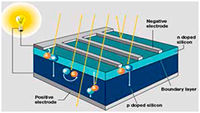Knowledge fuels change
For over a decade, Energypedia has shared free, reliable energy expertise with the world.
We’re now facing a serious funding gap.
Help keep this platform alive — your donation, big or small, truly matters!
Thank you for your support
Difference between revisions of "SPIS Toolbox - Solar Generator"
***** (***** | *****) m |
***** (***** | *****) m |
||
| Line 1: | Line 1: | ||
| − | |||
{{SPIS Banner}} | {{SPIS Banner}} | ||
| Line 27: | Line 26: | ||
A set of solar panels are connected to each other in series, parallel or a combination thereof, depending on the required electrical output (voltage, current and power). Combining solar panels in series means connecting the positive terminal of one panel to the negative terminal of the next panel. It allows you to build up the voltage to the level you need (as opposed to parallel wiring, which allows you to increase current/amperage). | A set of solar panels are connected to each other in series, parallel or a combination thereof, depending on the required electrical output (voltage, current and power). Combining solar panels in series means connecting the positive terminal of one panel to the negative terminal of the next panel. It allows you to build up the voltage to the level you need (as opposed to parallel wiring, which allows you to increase current/amperage). | ||
| + | {{SPIS Reference}} | ||
---- | ---- | ||
<br/>[[#_ftnref1|[1]]] IEC – International Standards and Conformity Assessment for all electrical, electronic and related technologies. | <br/>[[#_ftnref1|[1]]] IEC – International Standards and Conformity Assessment for all electrical, electronic and related technologies. | ||
| − | <br/> | + | <br/> |
Revision as of 12:36, 26 May 2017

Introduction
Do want to know all about SPIS – Solar Powered Irrigation System : Please go to the newly launched standalone Solar Powered Irrigation Systems (SPIS) website (www.spis-toolbox.org) , featuring three SPIS toolbox:
- Toolbox for beginners,
- Toolbox for farmers (new SPIS Web based App – to calculate design of the pumps),
- the Toolbox for experts - the updated version - Version 6
and additional resources (Publication about SPIS).
The Toolbox on Solar Powered Irrigation Systems (SPIS) is designed to enable advisors, service providers and practitioners in the field of solar irrigation to provide broad hands-on guidance to end-users, policy-makers and financiers. Risks related to system efficiency, financial viability and the unsustainable use of water resources can thus be minimized. The Toolbox comprises informative modules supplemented with user-friendly software tools (calculations sheets, checklists, guidelines). read more
Modules and tools touch upon:
- assessing the water requirements,
- comparing the financial viability,
- determining farm profitability and payback of investment in SPIS,
- sustainably design and maintain a SPIS,
- highlight critical workmanship quality aspects,
- and many more.

Solar Generator
The solar generator provides the energy needed to operate the motor pump unit. It is made up of a set of solar panels that consist of individual solar cells. The individual solar cells make use of what is known as the photovoltaic effect, which converts light directly into electricity. Solar cells are made of specially prepared semiconductor materials such as crystalline silicon. When light falls onto the surface of the semiconductor, an electric field develops. This works best with the sun shining directly on the cells, but it also works with indirect solar radiation. On a cloudy day, solar panels can typically produce 10-25% of their rated capacity. By connecting a wire to the back of the solar cell, the voltage of the electric field causes an electric current to flow.
The solar cell
To protect the cells against mechanical stress and humidity, the cell strings are embedded in a transparent bonding material (e.g. EVA), which also insulates the cells electrically. For structural stabilization and electrical insulation, they are usually placed between a plastic cover on the rear side and a glass cover on the front side. The laminate is then protected by an aluminum frame, which allows the panels to be mounted on a mounting structure.
Solar panels are usually certified by the International Electronical Commission[1] and this approval certificate has become generally accepted worldwide as one of the quality marks for solar panels. IEC standard testing, however, does not assess the durability of solar modules over a 25 year period. Standard panels typically come with a 10 year product guarantee and a linear 25 year performance warranty that guarantees at least 80% power output by the end of the 25th year.
|
Note: Solar panels are rated in peak watts (Wp) according to their output under internationally defined Standard Test Conditions (STC): (Irradiance = 1,000 W/m², cell temperature = 25°C, air mass (AM) = 1.5) |
The panels’ electrical power mainly depends on the solar irradiance captured by the panel and the solar cell temperature. Solar cell temperatures increase significantly under normal operation and may easily reach 40 to
65ºC, depending on the site-specific conditions. This leads to a lower electrical power output as compared to STC. The temperature coefficient (TC) describes the power reduction for each ºC increase in temperature, and for crystalline silicone cells it is approximately -0.5% per ºC.
A set of solar panels are connected to each other in series, parallel or a combination thereof, depending on the required electrical output (voltage, current and power). Combining solar panels in series means connecting the positive terminal of one panel to the negative terminal of the next panel. It allows you to build up the voltage to the level you need (as opposed to parallel wiring, which allows you to increase current/amperage).
[1] IEC – International Standards and Conformity Assessment for all electrical, electronic and related technologies.




















